 Hotel Algonquin, 1904. The Hotel Algonquin occupied a commanding eminence at the foot of Algonquin Avenue, on the shore of Lower Saranac Lake. It was built in 1884 by Jabez D. Alexander of Vermontville and named "Alexander's". In 1890, the hotel was purchased by John Harding, a Paul Smith protege, who renamed the "Algonquin". William Morris spent time at the Algonquin after he was diagnosed with tuberculosis before he built Camp Intermission. 1
Hotel Algonquin, 1904. The Hotel Algonquin occupied a commanding eminence at the foot of Algonquin Avenue, on the shore of Lower Saranac Lake. It was built in 1884 by Jabez D. Alexander of Vermontville and named "Alexander's". In 1890, the hotel was purchased by John Harding, a Paul Smith protege, who renamed the "Algonquin". William Morris spent time at the Algonquin after he was diagnosed with tuberculosis before he built Camp Intermission. 1
It established a reputation for luxury, modern technology, and fine cuisine. In 1914, the hotel was leased and used as a tuberculosis sanatorium; it failed within two years and resumed operation as a hotel, from 1920 to 1922. The Algonquin was owned and managed by William M. Hanes. The great depression, and two world wars took their toll on the aging structure; in the 1940s, there were briefly plans by the Gladd Brothers to turn the property into a "year round camp site and sports center", presumably with the building demolished. 2 In the 1950s, Edmond Guggenheim purchased the property after it fell into disrepair; he donated it to the Trudeau Institute and in 1964 it became the site of the new Institute's scientific laboratories and offices.
Marie Leis Pearce, who grew up at the top of Algonquin Avenue in the 1920s, wrote:
The Algonquin Hotel ... was a lively place, crowded with visitors and having many activities. I can still remember the big parties they used to have. The hotel and all its verandas were lighted up and there was a platform in front of the hotel where an orchestra played and we could dance. Of course, there were plenty of drinks.
[T]here was also a boat house ... where we kept our boats, some purchased by our cousins for them to use when visiting. This open stretch of water is where they held the big motorboat races several summers. All the wealthy boat owners such as Guggenheim and Budweisser raced their speed boats. For a couple of days, there was a deafening roar which could be heard all the way to our house.
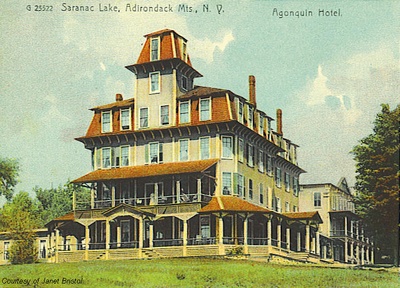 Hotel Algonquin postcard, 1908. Adirondack Daily Enterprise, December 30, 1986
Hotel Algonquin postcard, 1908. Adirondack Daily Enterprise, December 30, 1986
Remembering the heyday of the Algonquin Hotel
Where the Trudeau Institute is presently located on Lower Saranac Lake there once stood a very popular hotel. In 1884 Jabez Alexander chose this piece of headland to be the site of his hostelry because of the fine view it afforded over the lake toward Eagle Island and Boot Bay Mountain. Today this same panorama can be enjoyed through the Institute's library window or by standing next to Dr. E.L. Trudeau's reclining stone image which faces this commanding vista.
Alexander ran the hotel until 1890 when it was purchased by John Harding who changed the name from "Alexander's" to "The Algonquin." Harding had served his apprenticeship in the hotel business under that master of all innkeepers, Paul Smith. He immediately enlarged the original house by adding the fourth floor, an imposing tower, and an annex. Miller's, which was formerly Martin's, had burned down in 1888 and since it was located a short distance away Harding probably hoped to capture a big share of that clientele.
 Hotel Algonquin postcard, private collection, 2009.
Hotel Algonquin postcard, private collection, 2009.
A glimpse of the Algonquin register proves that his intuition was correct. A great many of the names that appeared in the Martin registers also show up in the pages on the Algonquin's desk. Many of the guides who once gathered at Martin's "hole in the house" found new employment with Harding's guests.
John Harding was born in Devonshire, England, in 1862 and came to this, country with his parents at the age of six years. Nine years later, at the tender age of 15, he went to work at Paul Smith's Hotel on Lower St. Regis Lake where he learned the hotel business from the bottom up. In 1888 (again the same year that Martin's burned) he was hired as manager of the brand new Hotel Ampersand at the eastern tip of Lower Saranac Lake. It was from this position that he made the move to purchase Alexander's two years later. At age 28 Harding was a handsome young man with a pleasant personality and keen business acumen. All of these factors led to his popularity and to the evident success of the Algonquin. He took a strong interest in local affairs and in 1891 was elected Supervisor of Harrietstown.
Feeling at home
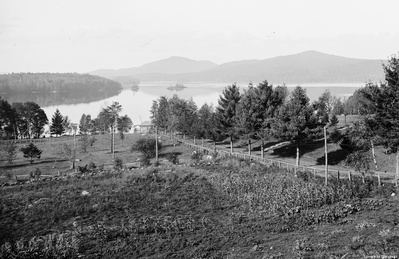 The approach to the Algonquin on Algonquin Avenue, 1900-10.
The approach to the Algonquin on Algonquin Avenue, 1900-10.
An article in the "Summer Resorter" for July 14th, 1897 offers an insight to affairs at the Algonquin in that era: "I always like to go to the Algonquin. There is something about the place that makes one feel at home almost the instant one arrives. It is more like the home of a big happy family, than a fashionable summer resort. Mr. Harding, who does not object to being called Jack, although he is the head of this large property (and this situation certainly is magnificent), is so cordial that he seems to infuse something of this spirit into his guests. If you are feeling blue, and things are kind of out of sorts, my advice is come and stay awhile with Jack. Many well-known people have engaged rooms, and the Algonquin promises to be the scene of unusual social life and activity during the season."
A later issue of this same periodical states that "Mr. Harding surely will have to buy a new register." All of which shows the popularity of the place under Harding's management. After such favorable remarks there always followed a lengthy list of current registrants at the hotel. Among the prominent names from our own country there often can be found names of international interest. On Sept 4th, 1897, for example, two entries read as follows: "The Honorable Clifford Sipton, of the Dept. of the Interior of the Canadian Govt., and family, are here from Ottawa for September." And "Moustopha Bey, the Turkish minister to the United States, and Seifidden Bey, Secretary of the Turkish Legation, are guest at the Algonquin."
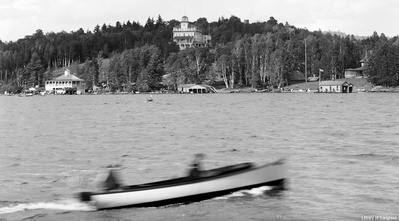 The Algonquin from Oswego Point - the speeding boat and the crowd on shore suggests that a regatta was in progress (Detroit Publishing, 1905-1920)
The Algonquin from Oswego Point - the speeding boat and the crowd on shore suggests that a regatta was in progress (Detroit Publishing, 1905-1920)
Skating promoter
In addition to all of the summer activity Harding played an active role in the winter events which took place in the village. He served on various Winter Carnival committees and was a staunch promoter of the skating races at the old Pontiac Rink. In 1815 he was elected Secretary-Treasurer of the International Skating Union, the prestigious organization which ruled over this popular sport. He also built the Harding Block which has long been a prominent commercial building at the corner of Main and Academy Streets.
This involvement in affairs of the village must have drawn him away, for a brief period, from managing the Algonquin. In 1913 he had leased the hotel to a Dr. Friedmann from Germany, who attempted to run the place as a health center. The venture was a failure so Harding took over once more in 1915 and ran the hotel until 1920 when the handwriting was on the wall for large resort hotels. The Hotel Ampersand had burned to the ground in September of 1907 but even this loss of competition brought no new business to the Algonquin.
This was the beginning of the demise for many of the old and famous Adirondack hotels. Many blamed the coming of the automobile for the decline in popularity of the resorts because families no longer cared to stay in one place for the season. In any event, Harding sold the Hotel in 1920 to William N. Hanes, of Winston-Salem "underwear" fame, who owned a summer camp on the lake adjoining the hotel grounds. The hotel proper soon became a derelict but the boathouse and cottages were leased by Burt Alvord who, together with his son, Earl, ran these amenities for many years. The boathouse was especially popular not only for boat rentals but as a take-off dock for the many owners of state campsites which bordered three quarters of the lake's circumference. After his father's death, Earl continued to run the boat business. He lived in the upstairs over the boathouse in the summer and in one of the cottages during the winter. He was extremely popular with local residents and was fondly known as the "Earl of Algonquin." He was also the area's champion checker player and many a game was played on the upper deck of the old boathouse on a summer's day.
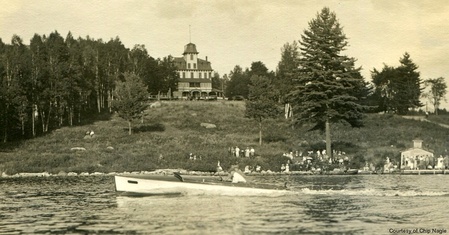 The speedboat Adios II with the Algonquin Hotel in the background (undated)
The speedboat Adios II with the Algonquin Hotel in the background (undated) 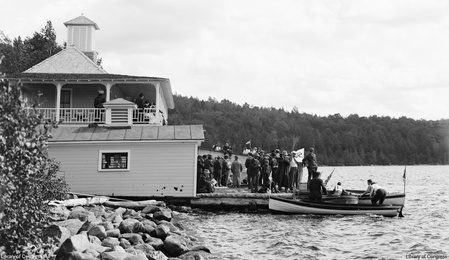 Algonquin Boathouse, c. 1912. Final phase
Algonquin Boathouse, c. 1912. Final phase
This, then, was the final phase of the Algonquin. Unlike many of the Adirondack hotels such as Paul Smith's, Loon Lake, Martin's, and the Ampersand the Algonquin did not go down in flames. Eventually both the hotel and the boathouse had to be torn down leaving this choice piece of real estate in limbo. From directly across the lake came a solution to the impasse.
A wealthy camper, Edmond Guggenheim, whose property faced the Algonquin site from the opposite shore, purchased the property for reasons of his own. It could be that he wished to control the view from his own camp by protecting it from unwanted development but on the other hand he might have had philanthropic ideas at the outset. In any event, he donated the land to the Trudeau Institute and the present handsome building sits on the exact site of the old Algonquin Hotel.
And now a truly remarkable coincidence brings this story to its ending. When the American Management Association purchased the former Trudeau Sanitarium a small building, which housed the first of Trudeau's patients, was moved to its present site next to the Institute. This was "Little Red" a cherished relic of the healing days on Mt. Pisgah where it served as Cottage No. 1 on the grounds that grew into the world famous sanitarium for the cure of tuberculosis. Should you visit the site on a fine summer day to enjoy the spectacular view up the lake, take a moment to note the date appearing in the front gable of "Little Red." It reads 1884 the exact same year that the original Algonquin was built!
Ogdensburg Journal, August 13, 1886
LOST IN THE W1LDEBNESS.
A New York Gentleman's Frightful Experience In the Adirondacks.
While sitting around their camp-fire near Saranac Lake one night last week, a party of gentlemen heard a faint and piteous cry for help come across the water from the upper opposite shore. They answered the cry, and made out that some one wanted a boat sent to his relief. They hastily fitted out two boats and sent them out in the darkness in the direction whence the cry came. Upon reaching the place they found upon the beech Mr. Samuel Untermeyer, of New York, with no clothes except a Norfolk jacket. He had started from Alexander's at Lower Saranac lake, but he had got into an old lumber road, and about 7 o'clock p. m. found that he was lost. After fording a number of brooks and stumbling through marshes his horse gave out, and leaving the animal he started on foot in the direction of the lake, but before he reached the shore his clothes became so wet that he left nearly all of them.
He then waded along a brook until he reached the lake, and then after wading about for about two hours he saw the lights of the house and camp-fire and called for assistance, when his shouts were fortunately heard. He was completely exhausted and was at once taken to the hotel and everything done for his comfort. In the morning a guide was sent out to look for his clothes and horse. He succeeded in finding the former but the horse had started homeward some time in the night. Mr. Untermeyer felt much rested the following day and has since left Saranac for Alexander’s. [sic]
—Albany Journal.
Plattsburgh Sentinel, May 25, 1888
SARANAC LAKE.
[...] Also the Alexander Hotel has been undergoing some improvements, all the rooms being supplied with hot and cold water...
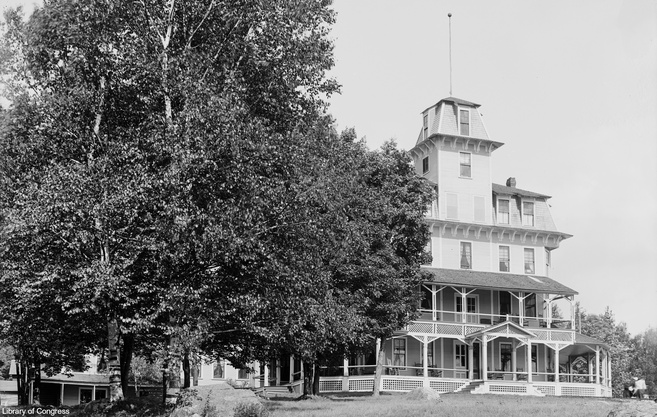 The Algonquin, Detroit Publishing, between 1900 and 1910New York Times, June 11, 1893
The Algonquin, Detroit Publishing, between 1900 and 1910New York Times, June 11, 1893
BEAUTIFUL SARANAC LAKE.
An Ideal Spot in Which to Spend the Hot Summer Months.
Saranac Lake, June 10.—This beautiful spot, with its peaceful waters, gentle, undulating vales, emerald forests, and surrounding lofty, pine-clad mountains, was never lovelier than now. Already the invasion of "summerers" has not only begun, but has continued for several weeks, and the various resorts are rapidly assuming a businesslike air.
…The Algonquin throws open its doors today. It is under its former manager, John Harding. Many well-known New-Yorkers have engaged accommodations, and applications for rooms are received daily- Mr. Harding will, in a few days, resume his four-horse tally-ho coaching parties, and continue them through the season. The Algonquin is most superbly situated, commanding magnificent vistas of mountain, wood, and the island-studded waters of the lake, while a refreshing breeze Is always felt, even on the sultriest days.
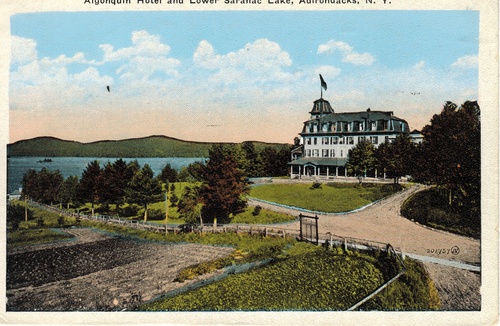 Post Card depicting Algonquin Hotel and Saranac Lake, TCR 300
Post Card depicting Algonquin Hotel and Saranac Lake, TCR 300
New York Times, June 27, 1897 (A pdf of the full article is here)
ON MOUNTAINS AND LAKES
The Numerous Adirondack Resorts Now Ready to Receive the Summer Visitor.
[...]
The Algonquin, which is also on the lower Saranac, is another widely known resort. It has been entirely renovated and repainted since the snow melted...
From Seneca Ray Stoddard's 1908 The Adirondacks, Illustrated
The Algonquin has a most attractive location on high, open ground on the east side of Saranac Lake, exposed to the west winds, which is an appreciable advantage during the warm weather. To the ordinary tourist and sportsman it is specially desirable as a stopping place. It commands from its high position an extended view of the broad lake with its islands and the shores beyond. The house is owned and managed by John Harding. The sleeping rooms are large, above the average, open fireplaces afford ventilation, and, on occasion, necessary heat. Wide piazzas give 300 feet of promenade from rain and sun. The house has electric lights throughout. The grounds have three fourths of a mile of lake front, with beautiful sand beach, and pleasant walks penetrate the thick Woods, affording means of open or covered promenade as may seem more pleasant. Amusements are fishing for small mouthed black bass, boating, golf, tennis, etc.
At the lake side is a picturesque boat house, the upper portion divided into pleasant rooms to be used for social gatherings or dormitories.
Stages run from the Algonquin to all trains; fare 50 cents. A postoffice, telegraph and telephone are in the hotel office. Rates, $4 up per day; $21 up per week.
Plattsburgh Sentinel, July 25, 1913
Tuesday, August 12th is the date set by State Commissioner of Health Porter for the hearing to establish a Sanitarium at the Algonquin, Saranac Lake. The hearing is to take, place at Albany, before Dr. Porter and Dr. C. F. Wicker, health officer of Harrietstown, and argument for or against the proposed enterprise will then be heard. Dr. Wicker is said to be in favor or the undertaking. Dr. Rambaud, who is to be medical superintendent, says he is anxious to experiment with the Friedmann cure under the most favorable circumstances and ascertain for the benefit of humanity what its merits are. Notwithstanding the recent action of the Saranac Lake Board of Trade in opposition to the Friedmann Sanitarium a good many of the principal businessmen favor it, and for once the Saranac lake tuberculosis specialists may not have their way.
From Alfred L. Donaldson's 1921, A History of the Adirondacks, v. 1, p. 38
In the spring of 1913 it was leased to a syndicate who converted it into a sanatorium for the Friedmann treatment of tuberculosis.
During the previous winter Dr. Friedmann of Berlin had made copy of all the newspapers by announcing that he had discovered a turtle serum that was highly efficient as a cure for tuberculosis. Around his name and his claim a wordy warfare immediately began to rage. Later the German doctor visited America and sold the bottling rights of his cure to an American syndicate. An outgrowth of this was the leasing of the Algonquin and the advertising of it as "The Lower Saranac Lake Health Resort." The venture proved ill-advised and ephemeral. It closed its doors abruptly, and without honor, on January 21, 1914; and the hotel's brief career as a sanatorium passed into history. It was reopened by Mr. Harding in 1915, and has since been run by various lessees. In 1920 it was bought by William N. Hanes of Winston Salem, N. C.
Adirondack Daily Enterprise, March 8, 1976
Hotel Algonquin heydays: robins for dinner
SARANAC LAKE — You may or may not entertain preconceived ideas that gracious living in the Adirondacks was restricted to the glorious era of plush hotels. The fact remains that the gently paced years of the 1880's definitely added luster to the shining pages of Saranac Lake history.
 Hotel Algonquin Display, courtesy of Betty Hanes and Kathy Ford, Shown at History Day 2008. Click on the image to enlarge the display The Algonquin Hotel is still vivid in the minds of many since it was not torn down until 1947, and though vacant for 30 years, its ghostly eminence overlooking Eagle Island was as much a lighthouse on the seashore as a landmark.
Hotel Algonquin Display, courtesy of Betty Hanes and Kathy Ford, Shown at History Day 2008. Click on the image to enlarge the display The Algonquin Hotel is still vivid in the minds of many since it was not torn down until 1947, and though vacant for 30 years, its ghostly eminence overlooking Eagle Island was as much a lighthouse on the seashore as a landmark.
The smartly clad bellhops carried their last luggage along the halls of the Algonquin back in 1917.
Boaters in the 20's and 30's, rowing down Lower Lake towards Crescent Bay at twilight were often overcome with an eerie feeling that lights were burning in the upper tower as the last flickering rays of the sun reflected in the high windows.
There were many ways of getting inside the cavernous old ruin, and one could prowl the halls and stairways which once echoed to the laughter and conversation of a genteel class of summer residents.
The four story wooden structure with a wide veranda along the front and one side and its adjacent two cottages accommodated about 100 guests. Three bathrooms to each floor apparently was not considered an inconvenience.
Like all mountain hotels of that period, the heads of wild animals were mounted in the office and over the dining room fireplace. Local birds, a wildcat, an elk, and a moose shared space in compatible stuffed silence.
The hotel had its own post office, "Algonquin .N.Y.," and took care of the hotel guests as well as campers around the lake. The hotel also boasted its own private telegraph line.
The Hardings, who ran the hotel, were gracious hosts and their guests were charged $21 a week on the American plan, (room and meals).
Waitresses received $3 a week in wages and some of the prettiest girls in the East could be found working the dining room where even the breakfast menu included tenderloin and sirloin steak, lamb chops, bacon, eggs, and boiled spring chicken on Sundays.
[The remainder of the article is missing.]
Malone Gazette, May 4, 1894
Mrs. Emma Harding has been appointed postmaster at the Algonquin, a leading Adirondack hotel near Saranac Lake.
See also
Comments
Footnotes
1. Adirondack Daily Enterprise, Weekender, p. 2, October 14, 1995
2. Adirondack Record, September 11, 1941



